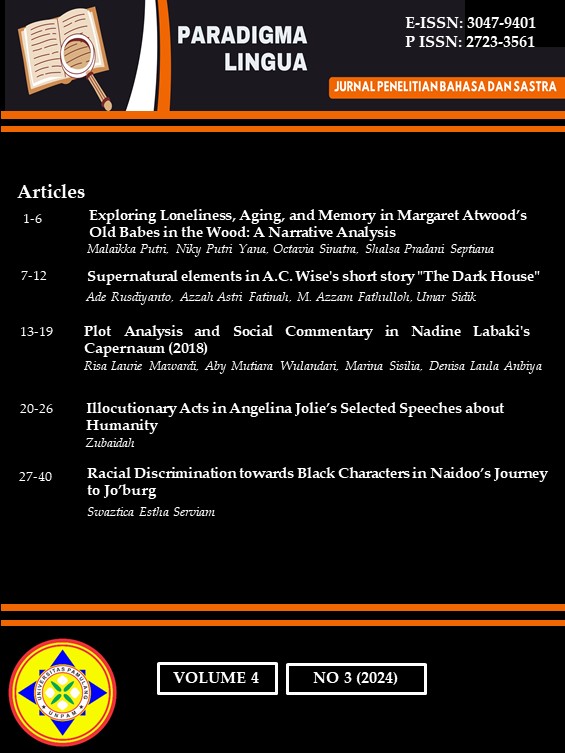Plot Analysis and Social Commentary in Nadine Labaki's Capernaum (2018)
Keywords:
plot analysis, film structure, Capernaum, social issues in cinemaAbstract
The plot structure plays a pivotal role in a film’s success, effectively guiding the audience through its narrative. As defined by Stanton (2007, p. 22), a plot is a series of interconnected events where each incident causes another, creating a cohesive storyline. This cause-and-effect dynamic significantly enhances a film’s engagement and emotional impact. One film that exemplifies this well-structured approach is Nadine Labaki's Capernaum (2018). The film tells the heart-wrenching story of Zain, a boy who escapes from his abusive parents and sues them for bringing him into a world of misery. “Capernaum” has received critical acclaim, winning numerous awards, including the Jury Prize at the 2018 Cannes Film Festival. This study uses Tasrif's theory, as cited in Nurgiyantoro (2013), to examine the film’s plot stages. Through a qualitative descriptive method, employing a narrative structure approach, the analysis focuses on the progression of events in the film. The data consists of dialogues, scenes, and imagery from Capernaum. The findings of this research outline five major plot stages: (1) the introduction of the situation, (2) the emergence of conflict, (3) the rising action, (4) the climax, and (5) the resolution. Each of these stages is examined to reveal how Capernaum underscores the systemic failures in protecting vulnerable children, serving not only as a powerful narrative but also as a compelling social commentary.
References
Abrams, M. H. (1999). A glossary of literary terms. Boston, MA: Heinle & Heinle.
Arikunto, S. (2013). Prosedur penelitian: Suatu pendekatan praktik. Jakarta: Erlangga.
Bergmann, B. (2017). Climax plot. LitCharts. https://www.litcharts.com/literary-devices-and-terms/climax-plot. Accessed June 17, 2024.
Bergmann, B. (2017). Exposition. LitCharts. https://www.litcharts.com/literary-devices-and-terms/exposition. Accessed June 17, 2024.
Downloads
Published
Issue
Section
License
Authors who publish with this journal agree to the following terms:
- Authors retain copyright and grant the journal right of first publication with the work simultaneously licensed under a Creative Commons Attribution License that allows others to share the work with an acknowledgement of the work's authorship and initial publication in this journal.
- Authors are able to enter into separate, additional contractual arrangements for the non-exclusive distribution of the journal's published version of the work (e.g., post it to an institutional repository or publish it in a book), with an acknowledgement of its initial publication in this journal.
- Authors are permitted and encouraged to post their work online (e.g., in institutional repositories or on their website) prior to and during the submission process, as it can lead to productive exchanges, as well as earlier and greater citation of published work (See The Effect of Open Access).
Paradigma Lingua have CC-BY-SA or an equivalent license as the optimal license for the publication, distribution, use, and reuse of scholarly work.
In developing strategy and setting priorities, Paradigma Lingua recognize that free access is better than priced access, libre access is better than free access, and libre under CC-BY-SA or the equivalent is better than libre under more restrictive open licenses. We should achieve what we can when we can. We should not delay achieving free in order to achieve libre, and we should not stop with free when we can achieve libre.


